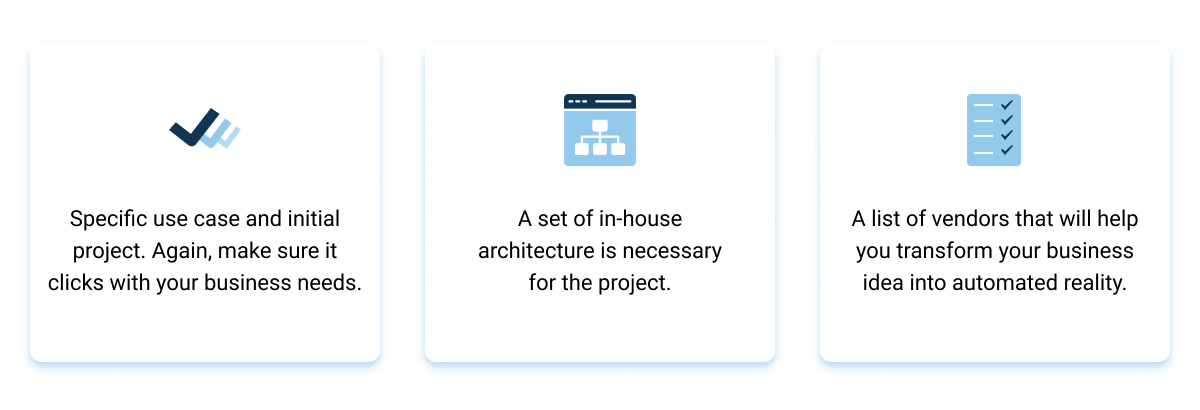A growing number of businesses are looking to maximize the value of insights for better business outcomes. A consistent AI implementation strategy is what can bring them closer to digital transformation and data-driven operations.
However, AI implementation comes in different flavors. Be it machine learning or predictive analytics, each use case should be justified. Therefore, companies should first start with a solid artificial intelligence strategy and realistic view, then think of the AI business strategy and implementation. They have to chart out the competitive advantages of implementing artificial intelligence.
With that in mind, we’ll lay out the nuts and bolts of a successful AI implementation strategy. By the end of this article, you’ll have a complete picture of how to develop AI innovation, future AI strategy and the challenges that might hamper it.
What is AI implementation?
The state of intelligent adoption looks encouraging. Over 85% of CEOs report extensive use of AI in their offices. Only 7% of companies don’t use innovative artificial intelligence solutions but are looking into it. Hence, we’re witnessing the limelight for AI implementation in business.

Source: Unsplash
There’s a lot of buzz around machine intelligence and artificial intelligence implementation. For businesses, artificial intelligence mainly boils down to three things:
- The ability to make sense of unstructured data (which isn’t possible with traditional or manual tools)
- Learning from historical data
- The ability to interact with the users in a human-like way – speech, chat, video, etc.
As such, an AI implementation strategy refers to transforming the information growth to business value. To do that, companies are investing in Big data and AI strategies. The latter lays out the step-by-step process of adopting tech-savvy solutions.
However, Artificial intelligence acts as only a supporting tool. It doesn’t replace human intelligence. Instead, it minimizes manual efforts and increases automation when applicable.
Where can an artificial intelligence strategy be implemented?
The application area of automation is massive. Every year we’re seeing an emerging batch of use cases. So, whether it’s your back- or middle office, intelligent systems can amplify business continuity and optimize your spending. Now let’s see which business case is better solved by artificial intelligence:
- Increase employee productivity by automating mundane and time-consuming tasks.
- Automate workloads by using algorithms to categorize data.
- Improve marketing pipeline by customizing marketing efforts for each customer.
- Optimize costs and time spent by replacing manual systems with intelligent ones.
- Predict business outcomes by analyzing past data and current trends.
- Prevent fraud by processing real-time data and comparing it with available datasets.
- Prevent asset outages by predicting failures.
This isn’t an exhaustive list of all AI applications. Based on your industry and objective, you can also make the most of analytical capabilities and automated efforts. The industry range of automation includes virtually every field – from commercial to public services to governmental use.
Where is artificial intelligence ineffective?
Today, machine intelligence is still in its immature form. Most often, we come across narrow-task models of algorithms that can accurately perform one task. Therefore, the implementation of AI doesn’t pan out in some cases.
Intelligent algorithms are unable to produce creative content or automate your marketing strategy. Smart systems act on data, but cannot write imaginative prose or brainstorm ideas. Also, companies shouldn’t count on artificial intelligence to make independent decisions or invent new solutions. Finally, machines cannot make ethical decisions, yet can eliminate bias when sourcing candidates, for example.
Thus, only consistent and timely implementation of AI can support business growth in the long-term perspective.
Why do you need a consistent AI implementation strategy?
Businesses that implement a strong AI-first approach can quickly react to shifting market conditions. Thus, companies can respond to new events more proactively. AI-centric approach also allows for solving existing business problems faster and more wisely.

Source: Unsplash
It’s a sobering fact that 80% of AI projects fail. Hence, it’s not enough to build the latest artificial intelligence software. You need thorough planning and accurate goals to set up your transformation for success. Otherwise, your AI projects are doomed to failure.
With that in mind, let’s have a look at common problems in AI while implementing AI projects. All of these can be eliminated or minimized once you pay due diligence to strategic planning.
Lack of quality data
The absence of meaningful, labeled training data sets is a common problem in AI adoption. Hence, the lack of availability of data for training is a key reason for failure. The right amount of data may vary depending on the type of AI being applied. Sometimes, during artificial intelligence implementation, you can even require thousands to millions of data examples to train the model.
Absence of unstructured data
Reports suggest that 62% of companies still rely on spreadsheets. Only 18% of respondents use unstructured data. The latter includes valuable insights such as product images, audio files, or comments on social networks. Instead, companies prioritize historical data which is out of context. This imbalance of data hampers the accuracy of smart solutions.

Source: Unsplash
Insufficient staff training
Getting your employees ready to work with smart systems is another success driver. Unless businesses prepare staff to use an AI solution, it will not scale. Also, some companies don’t realize the need to update traditional policies and enhance business support.
Misalignment with business goals
Clear business objectives lay the ground for maximum AI performance within the organization. When implementing business strategies that don’t anticipate technologies, automation fails to deliver desired results. That is why IT leaders should identify meaningful business problems. The latter should be backed by substantial data and have clear KPIs.
A dearth of AI talent
AI professionals top the list of emerging jobs on LinkedIn. It means that artificial intelligence talent is still scarce. This shortage cripples the massive adoption of intelligent solutions. However, companies need solid, multi-disciplinary talent to drive AI initiatives. This includes the team of data scientists to extract, clean, model, and analyze the data.
As you see, there is a lot to factor in when trailing the automation blaze. And this is exactly why you need a consistent AI strategy framework.
How to implement AI in business: main pointers
The road to automation success lies in the company’s ability to lay out strategic steps. A calibrated artificial intelligence implementation strategy will lead organizations down the path to leveraging and maximizing the benefits of AI technologies.
A proper artificial intelligence business model will also help achieve your goals of solving specific business challenges. Finally, you’ll be able to better identify unique resources for added business traction. Now, let’s overview the major milestones of artificial intelligence strategies.
Here’s a video that recaps the crucial aspects for a successful AI integration:
Getting started
You should start your journey by identifying the main building blocks. In particular, you should source as much strategic information as possible. It may sound cliche and simple at the first sight. However, discovery is pivotal to establishing a grounded action plan.
During this step, you will perform organizational research. The latter refers to the discovery of your company’s positioning in the business world. Here are some of the considerations to take note of:
- What are the primary goals of my company?
- What are our flagship products?
- What constitutes our expertise in the niche?
Within this frame, you should also analyze your competitive environment and industry tendencies. To do that, perform competitive research to uncover AI use cases in the industry. Also, discern the main similarities and differences between your company and your competitors.
Once you laid out your organizational specificities, audit your technical capabilities. This step will help you to target the right tech deficiencies when implementing artificial intelligence.
Explore the right use case
The next step is to identify and prioritize the suitable set of use cases for intelligent transformation. For starters, choose 3 to 5 application areas.

Source: Unsplash
To do that, you can assess the feasibility of each by evaluating the following metrics:
- Customer benefit
- Flagship feature
- Return on investment (ROI)
You should also perform interviews with in-house business units. This will help you to uncover the most important problems and pain points. After that, data scientists can identify solutions that can be solved with machines.
Create the enabling factors
You cannot successfully implement artificial intelligence strategies without doing your homework. Cutting-edge technologies require a robust IT infrastructure and consistent data management practices. The organization and the people must also be ready to embrace new assets. We’ll have a closer look at some of these catalysts below.
Get hold of your data
Making Big data management is virtually the most salient cornerstone for developing an AI solution. There’s a whole gamut of questions to ask:
- What kind of data do we need for our use cases?
- What is the state of available data?
- What internal and external data sources do we have?
- Is our data sufficient?
- What data is missing?
- How can we obtain needed data?
- What type of data storage do we use?
The main challenge of ineffective data management is siloed data. It means that corporational data often resides in multiple silos. The latter can be structured or unstructured. Thus, your data can flow from CRMs and ERPs as well as text messages and videos.
The nature and complexity of your smart project will define the type of data. Sometimes, it is a combination of both structured and unstructured data. Also, you may need to tap into external datasets to increase the algorithm accuracy.
In most cases, companies cannot perform a competent data audit in-house. That is why most of them turn to data scientists for a professional overview of data assets.
Maximize data privacy
The privacy violations in your data journey are another key factor. Some of the common privacy issues include repurposing and spillovers. In these cases, you either use data beyond its original purpose or embed non-target data in the training sets.
This induces a level of conflict that limits the collection of personal information and creates inherent privacy risks. That is why before curating the training elements, you must make sure all personal information is deanomyzed.
Prepare your human assets
Personal and organizational changes are inevitable when developing an AI solution. Over 3,500 business leaders find the AI skill-shortage among the top challenges in automation. That is why you should get your employees ready for AI and hire the missing talent.

Source: Unsplash
Developing new competencies isn’t always cost-effective. If it doesn’t make sense internally, you can outsource AI engineers or provide staff training. In any case, your workforce should have a basic understanding of how computing works.
Moreover, building a necessary IT infrastructure is a mandate before implementing your strategy. You should decide on the optimum storage option. The latter may include your own servers and GPUs or cloud-based infrastructure. This decision boils down to your unique privacy limitations, cost, and economic feasibility.
Build a strategic roadmap
Once you grapple with the main enablers, it’s time to devise an action plan. You will want to build a roadmap. It will demonstrate vetted opportunities prioritized to obtain strategic business goals. However, it’s not an exhaustive plan to drive your transformation. Instead, it kicks off the four pillars of adoption. We’ve already mentioned them: strategy, data, people, and governance.
You should also factor in the costs associated with each step. Although it’s hard to estimate the costs at the early stages, you can always consult an AI provider for further reference.
Overall, the costs depend on the software type and the amount of quality data. The algorithm’s accuracy and solution complexity also incur a great chunk of expenses.
Your roadmap should be based on the following milestones:

The final word
Creating business value from machine intelligence is a widespread model today. Some companies are already making the most of intelligent capabilities. Others are just looking into the realm of artificial intelligence. In both cases, a holistic AI strategy prefaces actual implementation.
Proactive planning and meticulous assessment of available resources is a starting point towards transformation. Data capture and competence as well as a viable use case and technical capacity are what set up your AI journey for success.



